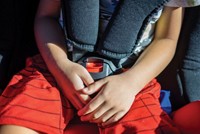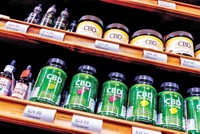Advertisement
Grab your lab coat. Let's get started
Welcome!
Welcome!
Create an account below to get 6 C&EN articles per month, receive newsletters and more - all free.
It seems this is your first time logging in online. Please enter the following information to continue.
As an ACS member you automatically get access to this site. All we need is few more details to create your reading experience.
Not you? Sign in with a different account.
Not you? Sign in with a different account.
ERROR 1
ERROR 1
ERROR 2
ERROR 2
ERROR 2
ERROR 2
ERROR 2
Password and Confirm password must match.
If you have an ACS member number, please enter it here so we can link this account to your membership. (optional)
ERROR 2
ACS values your privacy. By submitting your information, you are gaining access to C&EN and subscribing to our weekly newsletter. We use the information you provide to make your reading experience better, and we will never sell your data to third party members.
Policy
Lead Testing Clarified
Plastics and metals in toys will need testing, but new rule exempts many natural materials
by David J. Hanson
September 21, 2009
| A version of this story appeared in
Volume 87, Issue 38

The Consumer Product Safety Commission (CPSC) has made a final determination on what children’s products will have to be tested for lead under the new product safety law passed last year. Many items were determined to be naturally lead-free and therefore exempt from testing. But others, particularly items made from metals and plastics, will have to meet the law’s stricter standards.
In her first appearance before Congress since her confirmation, new CPSC Chairwoman Inez Moore Tenenbaum was asked, among other things, to clarify some points on lead testing in children’s products under the Consumer Product Safety Improvement Act (CPSIA). In her testimony before the House Subcommittee on Commerce, Trade & Consumer Protection on Sept. 10, Tenenbaum said her top priority since becoming chairwoman is to meet the CPSIA deadlines.
CPSIA was passed in 2008 in response to concerns over the presence of toxic materials, primarily lead and phthalates, in products sold to children (C&EN, Feb. 9, page 28). The law dramatically lowers the amount of lead permitted in children’s products of all kinds and bans three phthalates from toys. Specifically, the law reduces the allowed lead levels to 100 ppm by August 2011 in all products sold to children under 12 years old.
The initial reaction by many to the law was shock because it requires testing and certification of any and all children’s products already on the market, with severe penalties for selling items that do not meet the new standard. To clarify its stance on lead testing, the commission published a new rule in the Federal Register on Aug. 26. Earlier CPSC rules specified requirements for toy registration, tracking labels, and audits of third-party testing labs.
Aware of the concerns that many, particularly small businesses, have over how the law will be enforced, Tenenbaum told the subcommittee that the commission “will continue to solicit feedback from all involved parties and work to implement commonsense rules that are squarely focused on maximizing product safety.”
For its latest rule, CPSC listed a number of products that are naturally lead-free. Such products will be exempt from testing. “The commission has determined that some materials that fall below the lead content limits may be manufactured or man-made,” the rule states, opening the door to test exemptions.
One of the greatest concerns prior to CPSC’s newest rule was over children’s books. Under the law, these would have to be tested for lead, and everyone from publishers to librarians was worried about the cost and liability of such a task. The CPSC rule relieved those worries, stating that ordinary books manufactured today do not contain lead and will not have to be tested. Older books, specifically those printed before 1985, however, may contain some lead in the inks or bindings, but, the commission said, these vintage books are not usually marketed to children. CPSC is looking into the situation of older books in libraries and will make a determination on these later.
This CPSC rule also says that plant- and animal-based materials generally do not contain lead, and as a result, unadulterated products made from these materials can avoid testing. This includes natural fibers such as cotton, wool, or silk; materials such as coral, amber, and untreated leather; and other naturally derived products such as animal glue, bone, flowers, and seashells.
Foodstuffs used in products will not have to be certified lead-free either, the rule states. Some of the items CPSC says are exempt include vegetable and nut oils, food coloring and preservatives, dried beans and dried corn, and various natural waxes. Many of these materials are regulated by other agencies, such as the Food & Drug Administration. The commission noted that, according to the law, items such as cosmetics are actually excluded from the definition of “consumer products” and are therefore not regulated by CPSC.
Another large exclusion from the testing requirement is for textiles. On the basis of data submitted by manufacturers and associations, CPSC determined that textiles do not contain significant amounts of lead. The commission did, however, limit this to textiles that had no after-treatments, such as silk-screening or transfers.
Among the items that CPSC could not exempt from the testing requirement are metal products and items made with plastics. “The commission has found that these materials do sometimes contain lead,” the rule flatly states. For plastics, the rule gives numerous examples of lead-containing products, mostly plastics made with polyvinyl chloride such as baby bibs, toy umbrellas, telephones, and mini-blinds, with lead added to stabilize the plastic. CPSC says that the plastic degrades from sunlight and heat, generating lead dust in the home that could be ingested by children.
The determination for products made of metal is less straightforward. CPSC tested hundreds of pieces of children’s jewelry and other metal materials and found many, including pendants, charms, hooks, clasps, and beads, that contain high levels of lead; some are almost 100% lead. A lot of the products are primarily composed of copper, aluminum, pewter, and other alloys. Such products, the rule says, cannot be exempted from testing by manufacturers.
Other metals, however, may get a pass. The commission found that products made of titanium and most stainless steels do not contain lead. Thus, items made of these materials will not have to be tested. Similarly, other naturally occurring materials, such as gems and minerals, were also determined not to contain lead and therefore won’t need to be tested.
CPSC had received requests for exempting a lot of materials used in handcrafted items, including ceramic glazes and clay, glass beads on clothing, and art materials. Because many of these materials are known to contain lead, the commission concluded that all of them will have to be tested to ensure they meet the standard.
The verdict is still out, however, on how CPSC will regulate some lead-containing components of children’s products. These are parts that are not exposed and so aren’t a hazard to children, manufacturers argue. Tenenbaum said the agency is still working on how to address this issue, and she hopes that “the component-part-testing rule may untangle a lot of knots.”
At the subcommittee hearing, Tenenbaum was asked about the lead-testing decisions and whether the agency was being too stringent in some cases. “The law that was overwhelmingly passed by Congress says that no lead level is safe,” she said, adding that it doesn’t give the agency leeway on testing. “Under the older Federal Hazardous Substances Act, we had to determine if a product contained lead and could cause substantial illness. Under CPSIA, we don’t have to demonstrate that the products can cause illness,” only that they contain lead.
Tenenbaum also testified that the effort to meet the demands of CPSIA has overstretched the capacity of what she described as a dedicated CPSC staff and that she does not have adequate resources to implement the new law and perform all the agency’s other responsibilities.




Join the conversation
Contact the reporter
Submit a Letter to the Editor for publication
Engage with us on Twitter